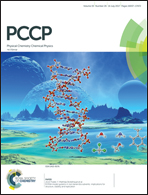Excitation-dependent local symmetry reversal in single host lattice Ba2A(BO3)2:Eu3+ [A = Mg and Ca] phosphors with tunable emission colours†
Abstract
Eu3+ activated phosphors are widely used as red emitters in various display devices and light emitting diodes (LEDs). The emission characteristics of Eu3+ depend on the local site symmetry. The present study demonstrates the role of excitation-dependent local symmetry changes due to the structural reorganization on the emission colour tuning of Eu3+ from orange-red to orange in single host lattices, Ba2Mg(BO3)2 and Ba2Ca(BO3)2. The choice of these lattices was based on the difference in the extent of strain experienced by the oxygen atoms. The samples with Eu3+ at Ba or Mg (Ca) sites were synthesized using the conventional high-temperature solid-state reaction method. The samples were characterized using powder XRD, 11B MAS-NMR, FT-IR, and diffuse reflectance UV-Vis spectroscopic techniques. The room temperature photoluminescence (PL) recorded using different excitation wavelengths revealed a clear difference in the PL emission features due to symmetry reversal from non-inversion to inversion symmetry around Eu3+. The reorganization of highly strained oxygen atoms leads to such symmetry reversal. First-principles calculations were used to deduce the optimized structures of the two borate host lattices, and local geometries and their distortions upon Eu3+ substitution. The outcomes of these calculations support the experimental findings.
![Graphical abstract: Excitation-dependent local symmetry reversal in single host lattice Ba2A(BO3)2:Eu3+ [A = Mg and Ca] phosphors with tunable emission colours](/en/Image/Get?imageInfo.ImageType=GA&imageInfo.ImageIdentifier.ManuscriptID=C7CP02740K&imageInfo.ImageIdentifier.Year=2017)


 Please wait while we load your content...
Please wait while we load your content...